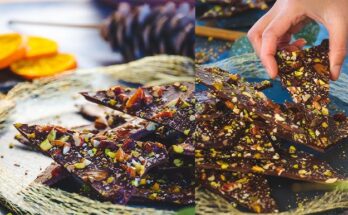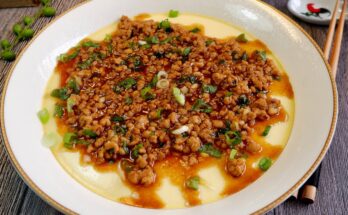Turkish Pasta Recipe: Turkish pasta, known locally as “makarna,” is a comforting, flavorful, and easy-to-make dish deeply rooted in Turkish home cooking traditions. Unlike Italian-style pasta that focuses heavily on olive oil, cheese, and herbs, Turkish pasta blends in robust spices, creamy yogurt sauces, and occasionally hearty meat toppings. This dish is more than just food—it’s part of everyday life in Turkish homes, quick to whip up after a long day, yet rich enough to serve guests with pride.
So, what makes Turkish pasta stand out? The secret lies in its simplicity and the bold yet balanced flavors. Think of soft-cooked pasta enveloped in a creamy yogurt and garlic sauce, then topped with sizzling butter infused with red pepper flakes. Or imagine pasta mixed with seasoned minced beef or chicken, garnished with a sprinkle of parsley. The combinations are endless, but the foundation remains the same—comfort, ease, and tradition.
Turkish pasta is also known for its affordability. Most ingredients are pantry staples: pasta, yogurt, garlic, and spices like pul biber (crushed red pepper flakes) and dried mint. It’s an ideal recipe for students, busy families, or anyone craving a satisfying, budget-friendly meal.
Let’s explore the ingredients, preparation, and cooking process step by step. Whether you’re a novice or a seasoned cook, this guide will walk you through creating a delicious Turkish pasta that will leave your taste buds craving more.
Essential Ingredients for Turkish Pasta
To make authentic Turkish pasta, you need just a few essential ingredients, most of which you might already have in your kitchen. The beauty of this dish lies in its flexibility. You can go classic with just yogurt and garlic or get creative by adding minced meat or vegetables.
Pasta Types Used in Turkish Cuisine
The most commonly used pasta type is macaroni or penne, but elbow pasta and fusilli are also popular. Turkish cuisine generally favors short-cut pasta varieties for better sauce absorption and ease of mixing. Long pasta like spaghetti or linguine isn’t traditionally used but can still work in a pinch.
Here are some Turkish-preferred pasta shapes:
- Makarna (macaroni) – Most popular and affordable
- Burgu (fusilli) – Holds sauces well
- Kelebek (farfalle/bow tie) – Used for more decorative presentations
Key Spices and Flavorings
The real charm of Turkish pasta comes from its seasoning and garnishing. Here’s what you’ll typically need:
- Yogurt – Full-fat is best for a creamy, rich base
- Garlic – Mashed or finely minced to infuse the yogurt
- Butter – Essential for frying the spices
- Pul Biber (Turkish red pepper flakes) – Adds a smoky, mild heat
- Dried Mint – For an earthy, fragrant twist
- Salt & Black Pepper – To season to taste
Optional ingredients:
- Minced beef or chicken – For a meatier version
- Tomato paste – To add depth and richness to the sauce
- Onions – Often used when making a meat sauce
With these ingredients in hand, you’re well on your way to preparing a classic Turkish pasta that’s bursting with flavor.
Preparing for the Recipe
Before jumping into the cooking process, it’s important to get organized. This will make your cooking smoother and faster, especially if you’re preparing it for guests or during a busy weeknight.
Tools and Utensils You’ll Need
- A large pot for boiling pasta
- A strainer or colander
- A mixing bowl for the yogurt sauce
- A small pan for frying butter and spices
- A large skillet if using meat
- Measuring spoons and cups
- A garlic press or grater
Make sure to have everything washed and ready. Turkish cooking is relatively fast-paced, so prepping ahead can save you from the chaos of last-minute chopping.
Ingredient Measurements and Prep Tips
Here’s a quick guide to measurements for 4 servings:
- 2 cups dried pasta (macaroni or penne)
- 1.5 cups plain yogurt (room temperature)
- 2 cloves garlic, minced
- 2 tbsp butter
- 1 tsp pul biber
- 1 tsp dried mint
- Salt to taste
Prep Tips:
- Bring yogurt to room temperature before mixing—it blends better and doesn’t curdle.
- Mash garlic into a paste using a pinch of salt for more flavor.
- Boil pasta until just soft—not al dente as in Italian recipes—Turkish pasta tends to be a bit more tender.
- If using meat, cook and season it before boiling your pasta to save time.
Once your ingredients are ready and your tools are set, it’s time to cook up your delicious Turkish pasta!
Step-by-Step Turkish Pasta Recipe
Now comes the fun part: putting everything together! Below is a traditional recipe for Turkish yogurt pasta with garlic and spicy butter sauce. Optional variations, including meat or tomato-based sauces, are also included later.
Step 1: Cooking the Pasta
Start by boiling water in a large pot. Add a generous pinch of salt, then pour in the pasta. Let it cook for about 8–10 minutes, or until soft and fully cooked (not al dente). Stir occasionally to prevent sticking. Drain the pasta and set aside, but don’t rinse it—the starch helps the sauce cling better.
Tip: Reserve ¼ cup of pasta water to help thin out the yogurt sauce if needed.
Step 2: Preparing the Sauce
In a bowl, mix the yogurt with the minced garlic and a pinch of salt. Stir until smooth. If the yogurt is too thick, add a spoonful of the reserved pasta water.
In a separate pan, melt the butter over medium heat. Add the pul biber and dried mint. Stir for 30 seconds until aromatic but be careful not to burn the spices. This spiced butter will go on top of the pasta later.
If you’re adding meat, cook it with a little oil, chopped onion, salt, pepper, and tomato paste until browned and crumbly. Set it aside.
Step 3: Mixing and Final Touches
In a large bowl or directly in the pot (if it’s still warm), mix the drained pasta with the garlic-yogurt sauce. Make sure every piece is coated.
Transfer the pasta to a serving plate or bowl. Drizzle the hot butter and spice mixture over the top. Add the cooked meat if using, and finish with a sprinkle of chopped parsley or extra dried mint for presentation.
That’s it—you’ve just made a classic Turkish pasta that’s ready to enjoy!
Serving Suggestions and Side Dishes
Once your Turkish pasta is hot and ready, it’s time to think about how you want to serve it. Although the dish is hearty enough to stand alone, pairing it with the right side dishes can elevate your meal and give you a complete Turkish dining experience.
Ideal Sides to Complement Turkish Pasta
- Cacık (Yogurt with Cucumber and Garlic)
This refreshing, tzatziki-like dish is a staple in Turkish cuisine and makes a great companion to pasta. The coolness of cacık balances out the spice and richness of the pasta sauce perfectly. - Çoban Salatası (Shepherd’s Salad)
A light, tangy salad made of chopped tomatoes, cucumbers, onions, and green peppers tossed in lemon juice and olive oil. It adds a crisp contrast to the warm, creamy pasta. - Turkish Pickles (Turşu)
Pickled vegetables such as carrots, cucumbers, and cabbage offer a delightful crunch and tanginess that cuts through the heaviness of the dish. - Flatbread or Pide
Fresh Turkish bread is ideal for scooping up the sauce. It’s also great for turning leftover pasta into a wrap. - Grilled Vegetables
Eggplant, zucchini, and bell peppers grilled with olive oil, salt, and pepper add a smoky, healthy touch that complements the pasta beautifully.
Plating Tips for a Traditional Experience
Presentation matters—especially if you’re serving guests. Here are a few simple tips to plate your Turkish pasta like a pro:
- Use wide, shallow bowls to hold the sauce and toppings properly.
- Drizzle the spicy butter over the top right before serving to highlight its rich aroma.
- Garnish with dried mint or chopped parsley for a pop of color.
- Serve with a wedge of lemon for a bright, acidic touch that some guests may enjoy.
Not only will these tips make your dish Instagram-worthy, but they’ll also add to the authentic experience of eating Turkish-style pasta.
Storing and Reheating Turkish Pasta
Made a big batch? No problem—Turkish pasta stores well and can be enjoyed over the next couple of days. Here’s how to store and reheat it while keeping its delicious flavor intact.
How to Store Leftovers
- Use airtight containers to store pasta in the fridge. This keeps the sauce from drying out and prevents the absorption of fridge odors.
- Separate the sauce from the pasta if you haven’t mixed everything together yet. This will preserve the yogurt’s texture.
- Consume within 2–3 days for best taste and quality. While it might still be safe after that, the yogurt sauce may start to separate or sour.
Tip: Avoid storing pasta with yogurt sauce in metal containers as the acidity from the yogurt may react with the metal, altering the flavor.
Best Reheating Methods
- Stovetop Method
Heat the pasta gently in a skillet with a splash of water or milk. Stir continuously to prevent sticking or curdling. Add a small knob of butter or a drizzle of olive oil to refresh the flavor. - Microwave Method
Place the pasta in a microwave-safe bowl. Cover it with a lid or plastic wrap (leaving a corner open). Heat in 30-second intervals, stirring in between, until fully warm. - Avoid high heat. Yogurt sauces can split when overheated. Always use medium or low heat and stir gently.
- Freshen up with extra yogurt. If your pasta seems dry after reheating, a dollop of yogurt can bring it back to life.
Proper storage and careful reheating ensure your Turkish pasta remains just as enjoyable the next day.
FAQs about Turkish Pasta Recipe
1. Can I use whole wheat pasta instead of regular pasta?
Absolutely! Whole wheat pasta adds a slightly nuttier flavor and more fiber. Just keep in mind it might need a minute or two longer to cook.
2. What meat works best in Turkish pasta?
Ground beef or chicken are the top choices. They cook quickly and absorb the spices well, adding a hearty element to the dish.
3. How can I make this vegetarian or vegan?
Skip the meat and use plant-based yogurt for a vegan option. You can also add sautéed mushrooms or zucchini for extra texture and nutrition.
4. Can I freeze Turkish pasta?
Freezing is not recommended for yogurt-based pasta, as the sauce tends to separate when thawed. However, you can freeze the cooked pasta and make fresh yogurt sauce when reheating.
5. What are some other popular Turkish dishes I can try?
If you love Turkish pasta, you might enjoy:
- Menemen (Turkish scrambled eggs with tomatoes)
- Lahmacun (Turkish pizza)
- Börek (flaky pastry with cheese or meat)
- Kuru Fasulye (white bean stew)
Conclusion
With just a few pantry staples, you can create a dish that feels indulgent yet familiar. The creamy yogurt, the punch of garlic, the heat from pul biber, and that golden butter—it all comes together in a beautiful harmony of textures and tastes.
And let’s not forget the flexibility. Add meat or keep it vegetarian. Spice it up or keep it mellow. The beauty of Turkish pasta lies in its adaptability. Once you try it, it’s bound to become a go-to recipe in your kitchen.
So why not give it a shot tonight? Gather your ingredients, roll up your sleeves, and let Turkish cuisine bring a little magic to your table.



